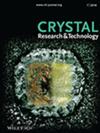溶剂性质对4 -氨基苯甲酮(ABP)单晶生长、形貌及二次谐波生成能力的影响
IF 1.9
4区 材料科学
Q3 CRYSTALLOGRAPHY
引用次数: 2
摘要
非线性光学应用中最著名的二苯甲酮衍生物之一,4 -氨基苯甲酮(ABP),在饱和溶液中以单晶体的形式生长,采用快速和缓慢的蒸发方法,在不同的溶剂环境下,通过不同的偶极矩、粘度和蒸发速率,如甲苯、乙醇、甲醇、乙酸乙酯、丙酮、二甲基甲酰胺、二甲基亚砜(DMSO)和乙醇- DMSO(1:1)的混合物,在32°C下生长。通过重量分析确定溶解度的变化,通过原位光学显微镜观察到的端晶形态,以及沿着不同晶体学方向观察到的生长缺陷的起源,根据溶剂的极性和上述物理性质允许的溶质-溶剂相互作用进行了研究。通过单晶和粉末X射线衍射、差示扫描量热法、紫外-可见-近红外光谱和傅里叶变换红外光谱分析,分析了Bravais - Friedel - Donnay - Harker形貌、晶体纯度、热稳定性、光学透射率和红外振动模式。通过Kurtz和Perry粉末技术研究了在不同溶剂和溶剂混合物中生长的ABP晶体的二次谐波产生(SHG)能力,并与无机和有机标准相比较。结果表明,在乙醇:DMSO(1:1)的混合溶剂环境中生长的ABP晶体最终具有更好的质量、尺寸和SHG能力。本文章由计算机程序翻译,如有差异,请以英文原文为准。
Effect of Solvent Properties on the Growth, Morphology, and Second Harmonic Generation Ability of 4‐Aminobenzophenone (ABP) Single Crystals
One of the best‐known benzophenone derivatives for nonlinear optical applications, 4‐aminobenzophenone (ABP), is grown as single crystals from saturated solutions employing fast and slow evaporation methodologies with different solvent environments by means of varied dipole moment, viscosity, and evaporation rates such as toluene, ethanol, methanol, ethyl acetate, acetone, dimethyl formamide, dimethylsulfoxide (DMSO), and a mixture of ethanol‐DMSO (1:1) at 32 °C. Variation in the solubility determined by gravimetric analysis, end‐crystal morphology perceived through in‐situ optical microscopy, and origination of growth defects observed along different crystallographic directions are investigated based on the solute‐solvent interactions permissible according to the polarity and aforementioned physical properties of the solvents. Bravais‐Friedel‐Donnay‐Harker morphology, crystalline purity, thermal stability, optical transmittance, and infrared vibrational modes are analyzed through the single crystal and powder X‐ray diffraction, differential scanning calorimetry, UV‐visible‐near IR, and Fourier‐transform infrared spectral analyses. The second‐harmonic generation (SHG) ability of the ABP crystals grown with different solvents and solvent mixture is studied through Kurtz and Perry powder technique in comparison with that of the inorganic and organic standards. The results reveal that the ABP crystals grown from mixed solvent environment ethanol:DMSO (1:1) to become eventually with improved quality, size, and SHG ability among the other crystals grown in the present study.
求助全文
通过发布文献求助,成功后即可免费获取论文全文。
去求助
来源期刊
自引率
6.70%
发文量
121
审稿时长
1.9 months
期刊介绍:
The journal Crystal Research and Technology is a pure online Journal (since 2012).
Crystal Research and Technology is an international journal examining all aspects of research within experimental, industrial, and theoretical crystallography. The journal covers the relevant aspects of
-crystal growth techniques and phenomena (including bulk growth, thin films)
-modern crystalline materials (e.g. smart materials, nanocrystals, quasicrystals, liquid crystals)
-industrial crystallisation
-application of crystals in materials science, electronics, data storage, and optics
-experimental, simulation and theoretical studies of the structural properties of crystals
-crystallographic computing

 求助内容:
求助内容: 应助结果提醒方式:
应助结果提醒方式:


